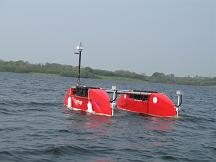An Obstacle Detection and Avoidance System for an Unmanned Marine Vehicle

Supervisors: Dr W. Naeem
Introduction
Autonomous marine vehicles (AMVs) are now in operation with applications ranging from subsea pipelines inspection to mines clearing operation and shallow water surveying. Generally, AMVs are classified into two main types,
- Autonomous underwater vehicles (AUVs) and
- Unmanned surface vehicles (USVs)
The autonomy of those systems largely depends on the robust
design of an integrated navigation, guidance and control system. A key
ingredient in the navigation process is the obstacle detection and
avoidance (ODA) module. This is imperative to ensure minimal human
intervention and hence improving the performance of the overall system
specifically in a hazardous environment where there is a potential
danger to the human life.
The AUVs generally make use of sonar to generate a map of their surroundings and hence detect and avoid any obstacle in their path. USVs, on the other hand, do not require expensive sonar equipment since they can utilise low cost vision and infrared sensors to detect a potential threat/obstacle along their trajectory. The intention of this project is therefore to develop a low cost obstacle detection and avoidance module which is portable and have the possibility of being integrated into any existing guidance and control system. The project will also investigate the affect of disturbances and the mobility of the obstacle.
Objectives of the proposed research
The research project is broken down into the following tasks:
- To understand the concept of obstacle detection and avoidance
- To investigate various existing ODA modules for airborne, marine
and land vehicles and to explore technology transfer within these
systems
- To conceptualise and develop an intelligent ODA system for
stationary and mobile obstacles which should be capable of rejecting
any external disturbances. This work should consider marine related
disturbances such as currents and waves
- To develop a stabilised tracking system which makes use of the ODA system developed above with little or no modification
- To deliver a laboratory platform for the evaluation of the above developed systems
